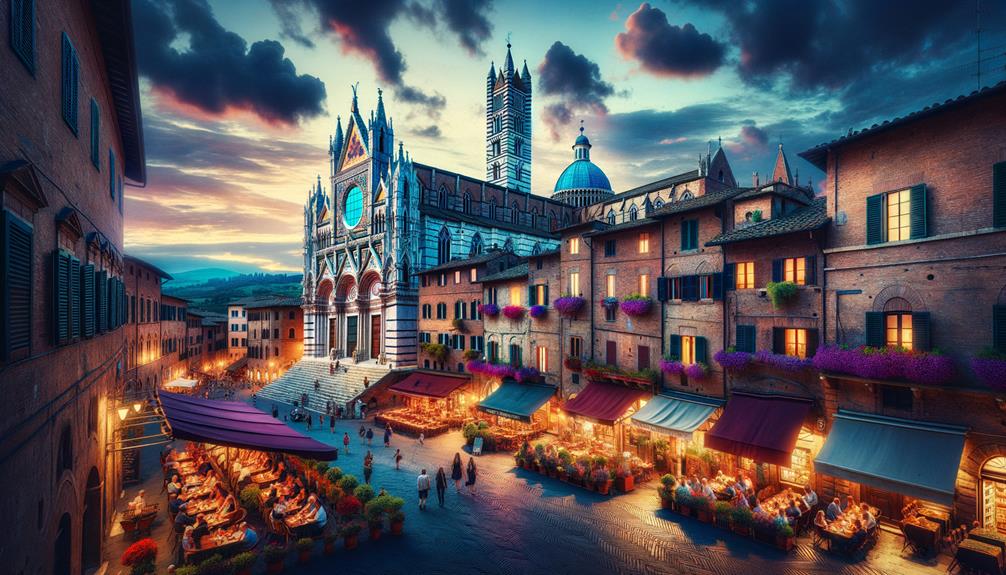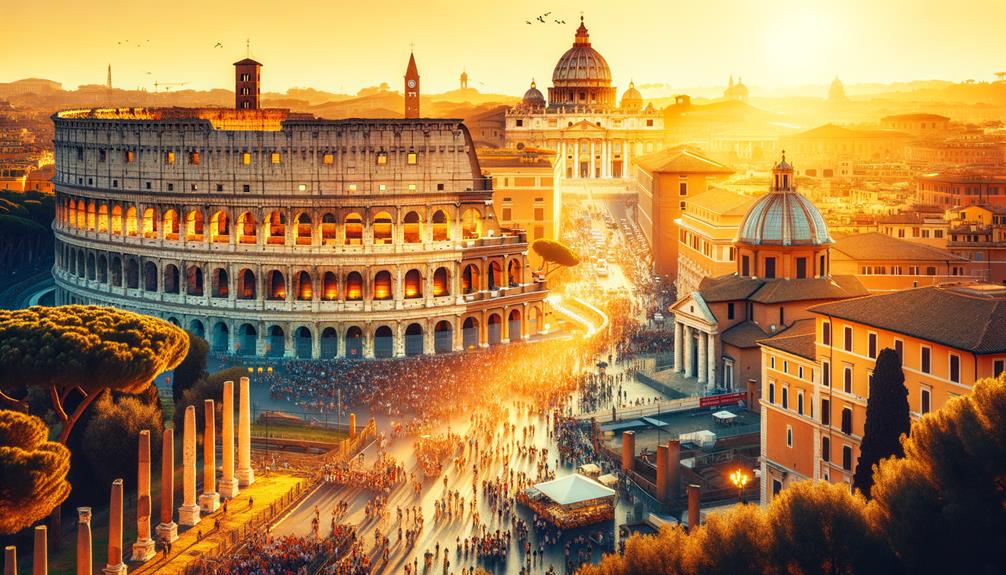Strolling through Siena feels like wandering into a living piece of history, with each cobblestone telling stories from centuries ago. As I made my way through the winding streets, Piazza del Campo opened up before me, a spot that has hosted numerous Palio races and town gatherings. The Siena Cathedral's stunning facade, a mix of Romanesque and Gothic styles, drew me in, and the detailed mosaic floor inside showcased the city's rich artistic past. Yet, it's the hidden gems, like the old Fontebranda and the frescoes in the Oratorio di San Bernardino, that whisper the secrets of Siena's lasting charm. What other hidden wonders might these medieval streets hold?
Siena's Historic Center
Tucked within its ancient walls, Siena's historic center offers a magical journey through time with its well-preserved medieval streets and iconic landmarks. As I strolled through the narrow, winding roads, it felt like I had traveled back to the 14th century. The city's layout remains untouched by modern urbanization, providing a rare window into the past. The cobblestone paths lead to the heart of Siena: Piazza del Campo, a remarkable square that fans out like a giant shell, inviting everyone to relax and soak in the atmosphere.
Standing in the Piazza del Campo, I was struck by the symmetry and elegance of the surrounding buildings, especially the Palazzo Pubblico. This grand structure, with its imposing facade, stands as a testament to Siena's rich history and cultural significance. The historic center, a UNESCO World Heritage Site, is bordered by ramparts that seamlessly blend into the city's current infrastructure, creating a harmonious mix of old and new.
Exploring Siena's historic center, I was enchanted by the stories embedded in its medieval architecture. Each alleyway, each stone seemed to whisper tales of a bygone era, making me feel part of something timeless and extraordinary.
Iconic Landmarks
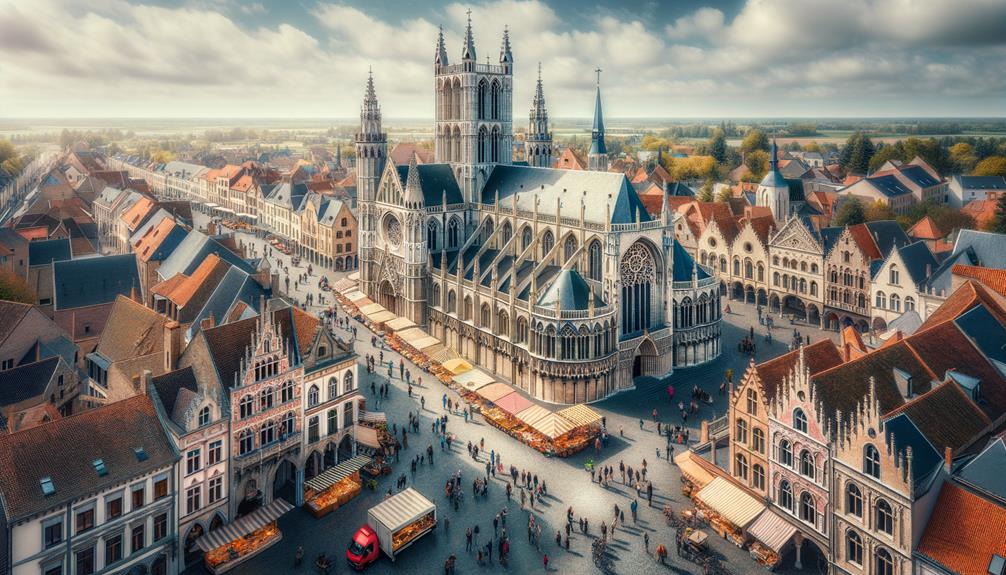
Strolling through Siena, I'm struck by its iconic landmarks. The impressive Piazza Del Campo, the detailed beauty of the Siena Cathedral, and the towering heights of Torre del Mangia all share tales of a rich medieval past. Each site pulls me deeper into the city's unique mix of history and artistry.
Piazza Del Campo
Have you ever found yourself in a place where history is alive around you, where the ground beneath your feet whispers stories of medieval splendor and community pride? Piazza del Campo in Siena is exactly that kind of place. This gorgeous square, at the heart of a medieval city, is a masterpiece of 14th-century urban design. With the imposing Torre del Mangia and the adjacent Palazzo Pubblico dominating the skyline, it's impossible not to sense the historical significance.
Standing in Piazza del Campo, I was immediately struck by its distinctive shell-shaped design, which seems to encourage you to stay and soak in the atmosphere. The gentle slope of the piazza, paved with red bricks, naturally guides you to the captivating Fonte Gaia, a beautiful fountain that adds a calming presence.
- Torre del Mangia: Provides incredible views of Siena.
- Palio horse race: A thrilling event held here twice a year.
- Fonte Gaia: Contributes to a peaceful ambiance.
- Palazzo Pubblico: A historical treasure with stunning architecture.
Experiencing Piazza del Campo, especially during the Palio, is like feeling the heartbeat of Siena itself.
Siena Cathedral Marvels
Leaving the lively Piazza del Campo, the Siena Cathedral's stunning Romanesque-Gothic facade drew me in with its detailed artwork. The exterior, featuring towering pinnacles and stern figures of prophets and patriarchs, is a testament to Siena's rich artistic heritage. Once inside the Duomo, the mosaic floor immediately caught my eye, with each tile telling a unique story through its centuries-old design.
The interior was filled with incredible art. Works by Donatello, Nicola Pisano, and Pinturicchio decorated the sacred space, each contributing to the cathedral's rich history. Among these, Duccio di Buoninsegna's pieces were particularly striking, especially his famous Maesta, a medieval masterpiece displayed in the Museo dell'Opera del Duomo.
The Museo itself was eye-opening, showcasing many original artworks commissioned for the cathedral. Each piece reflected Siena's noble heritage, highlighting its role in Italian culture. As I roamed the Duomo complex, I realized that even hours spent here only scratched the surface of its artistic and historical depth. This wasn't just a cathedral; it was a journey through the ages.
Torre Del Mangia
Standing at the base of the Torre del Mangia, I couldn't help but be impressed by the 102-meter-high medieval tower that offers panoramic views of Siena's landscape. As I started climbing the 131-step spiral stairwell, each step seemed to echo with history. Built in the 14th century and finished in 1348, the Torre del Mangia remains one of Italy's tallest towers from that time.
From the top, the view is simply breathtaking:
- Siena's iconic Duomo: A majestic sight with its striking black and white marble.
- Piazza del Campo: The heart of Siena, where the vibrant Palio horse race takes place twice a year.
- Palazzo Pubblico: The Gothic masterpiece that, alongside the Torre del Mangia, dominates the Piazza del Campo.
- Rolling Tuscan countryside: A patchwork of vineyards and olive groves stretching to the horizon.
Each vista gives a unique glimpse into Siena's rich cultural tapestry. The tower's bell, known as the 'Sun,' has marked many historic moments, adding to the sense of timelessness. Climbing the Torre del Mangia feels like a walk through Siena's storied past.
Exploring Piazza Del Campo
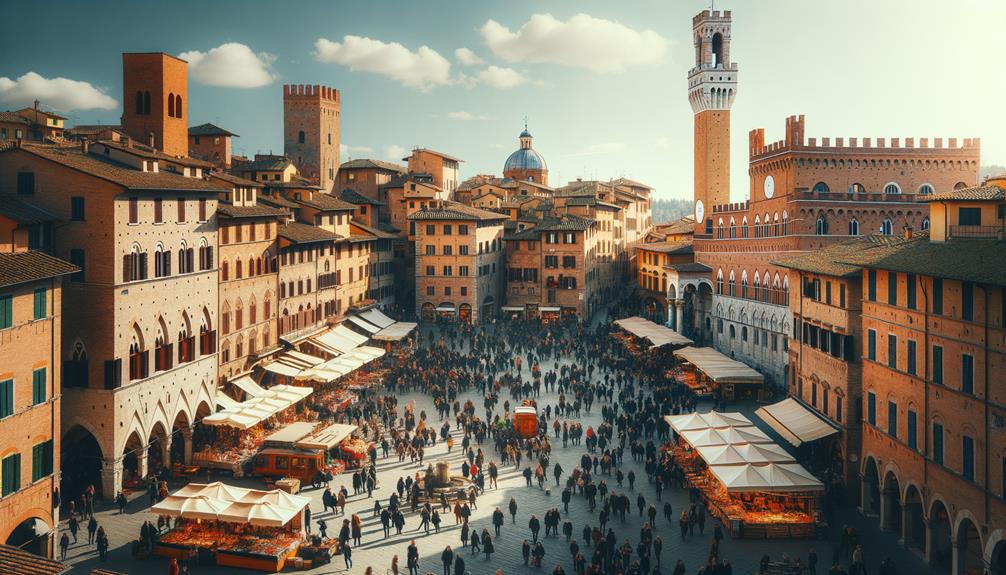
When I walked into Piazza del Campo, the medieval layout of the square immediately drew me in. The towering Torre del Mangia and Palazzo Pubblico stood out as reminders of Siena's rich history. The beautiful design of the place and the soft sounds from the Fonte Gaia fountain created a peaceful atmosphere in this lively spot.
Historical Significance Explored
Stepping into Piazza del Campo, I was immediately struck by its expansive, shell-shaped design—a brilliant example of medieval urban planning that has endured through the ages. The square's stones whisper the history of Siena, showcasing the city's dedication to preserving its heritage. The thoughtful layout, meant to encourage civic unity and social interaction, is apparent in every curve and corner.
The Palazzo Pubblico stands tall, a testament to Siena's historical governance, with the Torre del Mangia rising high above as a symbol of medieval power. The Fonte Gaia, with its 15th-century design, adds the calming sound of water, enhancing the square's historical atmosphere.
- Medieval planning: The square's unique design from the 13th century showcases innovative urban planning.
- Palazzo Pubblico: This building represents Siena's historical authority and governance.
- Fonte Gaia: An architectural marvel that adds both beauty and historical value to the piazza.
- Palio di Siena: The biannual horse race brings vibrant energy to the square, linking the past with the present.
Visiting Piazza del Campo feels like stepping back in time, immersing oneself in the rich history of Siena.
Architectural Marvels Unveiled
Looking at the Piazza del Campo, I'm struck by how seamlessly medieval architecture blends with the lively buzz of modern life in this incredible space. The piazza's shell shape, a masterstroke of 14th-century urban design, exudes a timeless charm. Dominating the scene are the Torre del Mangia and the Palazzo Pubblico, both standing as proud symbols of Siena's rich history. Their impressive stature reflects the city's long-standing power and elegance.
Walking across the gentle slope, the soft sounds of the Fonte Gaia fountain add a calming touch. With its cafes, restaurants, and shops, the piazza offers a snapshot of daily life in Siena. The unique nine-section layout, representing the Council of Nine that once governed the city, highlights Siena's dedication to preserving its heritage.
Twice a year, this peaceful setting transforms into an exciting venue for the Palio, a fiercely competitive horse race among the city's 17 districts. Nearby, the Duomo and the striking San Giovanni add even more layers to the Siena experience, making Piazza del Campo a true architectural gem.
The Magnificent Duomo
Sitting in the heart of Siena, the Duomo stands as a breathtaking monument to the city's medieval grandeur and artistic brilliance. This Romanesque-Gothic masterpiece, with its sparkling, pinnacled facade, is a treasure trove of artistic wonders. As I stepped inside, I was immediately struck by the late Gothic architecture, a testament to Siena's noble heritage.
The interior of the Duomo is nothing short of mesmerizing, with its incredible mosaic floor and masterpieces by Donatello, Nicola Pisano, Duccio, and Pinturicchio. Each corner reveals a new marvel, making it clear why this cathedral is considered one of the world's finest centers of art.
- Intricate carvings and statues: The facade is adorned with severe prophets and patriarchs, each meticulously crafted.
- Magnificent rose window: A stunning feature that draws the eye and fills the cathedral with ethereal light.
- Gothic-inspired bell tower: Rising 77 meters above the square, it's a true monument to medieval engineering.
- Historical significance: The construction began in 1215 and continued for over 200 years, weaving centuries of history into its stones.
Walking through the Duomo, I couldn't help but feel a profound connection to the past, particularly to Saint Catherine, whose legacy is intertwined with this magnificent structure.
Medieval Art and Frescoes
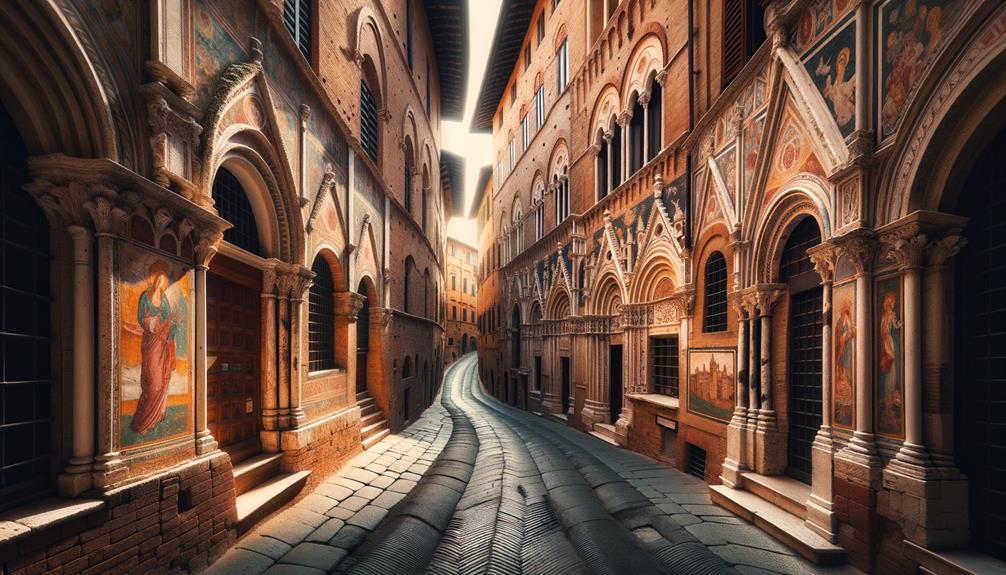
Strolling through Siena, the medieval architecture and frescoes present a vivid picture of the city's rich history and culture. The fresco cycle of Good and Bad Government in the Palazzo Pubblico is particularly striking. Ambrogio Lorenzetti's portrayal of civic virtue and vice tells a powerful story that still resonates today.
The Piccolomini Library in the Duomo is another highlight. Pinturicchio's frescoes are full of color and detail, depicting the life of Pope Pius II. The vibrant scenes transport you to another time.
In the Basilica of San Domenico, Simone Martini's work offers a glimpse into a world of spiritual devotion. His use of gold leaf and expressive figures reflect the religious fervor of medieval Siena. Giovanni Pisano's sculptures and reliefs in the Cathedral also stand out with their dynamic forms and emotional intensity.
In Siena, art isn't just seen—it's experienced. These frescoes and sculptures offer a window into a past filled with stories, passions, and a pursuit of beauty.
Hidden Gems
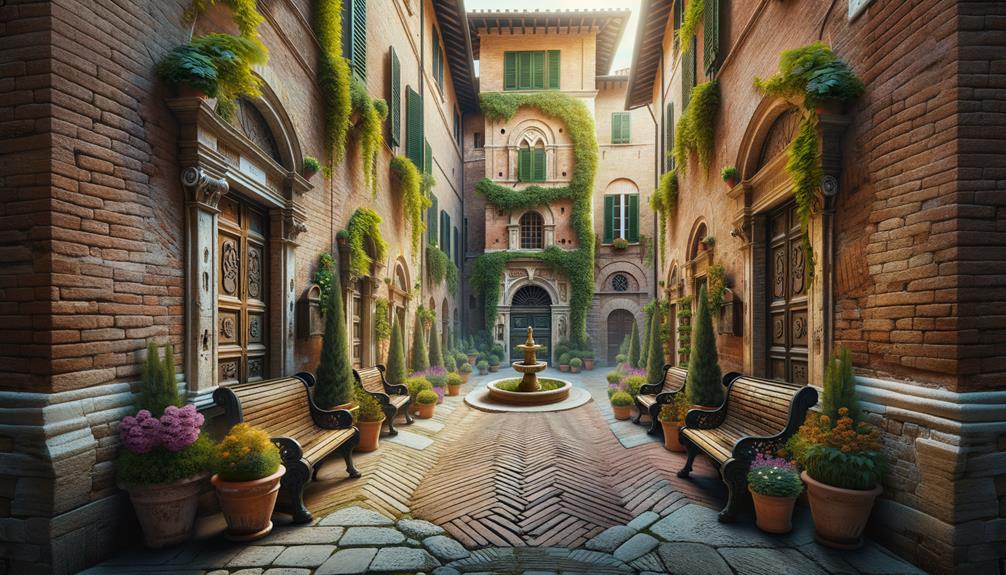
While Siena's famous art attracts many visitors, it's the lesser-known spots scattered around the city that truly showcase its character. Wandering through the narrow streets of the old town, I came across several amazing places that felt like hidden secrets.
One such place is Fontebranda, an ancient water system that highlights medieval engineering at its finest. Standing by its calm waters, you can almost hear the echoes of history.
The Oratorio di San Bernardino is another gem. This small chapel's frescoes, painted by Sienese masters like Sodoma and Beccafumi, are stunning and often missed by tourists.
Checking out the Contrada Museums was like stepping into another world. Each of Siena's 17 neighborhoods, or contrade, has its own museum filled with unique artifacts and stories. It's a quirky and intimate way to get to know the city's culture.
Lastly, the crypt of the Siena Cathedral is a hidden wonder. Its sculptures and frescoes, including a striking 13th-century Crucifixion, provide a peaceful escape from the busy streets above.
These hidden gems reveal a side of Siena that's rich in history and full of charm.
Experiencing the Palio

Experiencing the Palio in Siena is like stepping into a living tapestry of medieval tradition and intense neighborhood rivalry. The energy in Piazza del Campo is electric. Standing shoulder to shoulder with locals and tourists, the anticipation is almost overwhelming.
The horse race is a blur of colors and speed. Each contrada, or neighborhood, competes fiercely, with their honor on the line. Flags wave, drums pound, and the crowd cheers as horses race around the tight, dangerous corners. It's more than just a race; it's a showcase of centuries-old traditions and strong community spirit.
Here's a snapshot of the Palio experience:
| Sights | Sounds | Emotions |
|---|---|---|
| Medieval costumes | Roaring crowds | Adrenaline |
| Colorful flags | Galloping hooves | Excitement |
| Decorated horses | Drumbeats | Pride |
| Historic buildings | Trumpet calls | Unity |
| San Domenico backdrop | Cheering fans | Joy |
Walking back through Via Francigena, I felt a deep connection to Siena's history. The sense of freedom and celebration stayed with me, making the experience truly unforgettable.
Frequently Asked Questions
What Is the Emblem of Siena?
The symbol of Siena is the she-wolf, known as the 'Lupa,' which is said to have nursed the city's legendary founders. You'll notice it all over the place, from the city's coat of arms to the Palazzo Pubblico, as it plays a big part in Siena's history.
What Is Siena, Italy Famous For?
Siena, Italy is known for its beautiful medieval buildings, rich cultural history, and captivating art. As I wandered through its charming streets, I felt like I had stepped back in time, surrounded by Gothic architecture and bustling neighborhoods gearing up for the Palio horse race.
What Is the Medieval Town Near Siena Italy?
San Gimignano, a charming medieval town near Siena, caught my eye as I wandered through its narrow streets. The ancient towers and lively piazzas made me feel like I had stepped back in time. The town's historical appeal provided a perfect getaway into the past.
Why Does Siena Have Walls?
Siena's walls were put up to fend off invaders and mark its boundaries. Walking through these age-old gates, I could really feel the history and see how they helped Siena keep its distinct character and independence.

